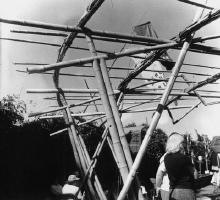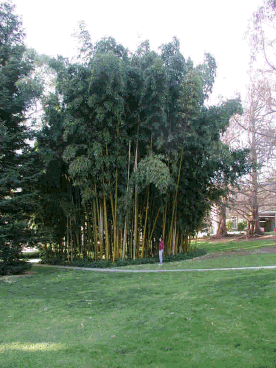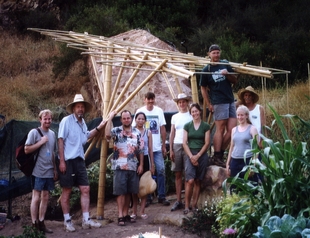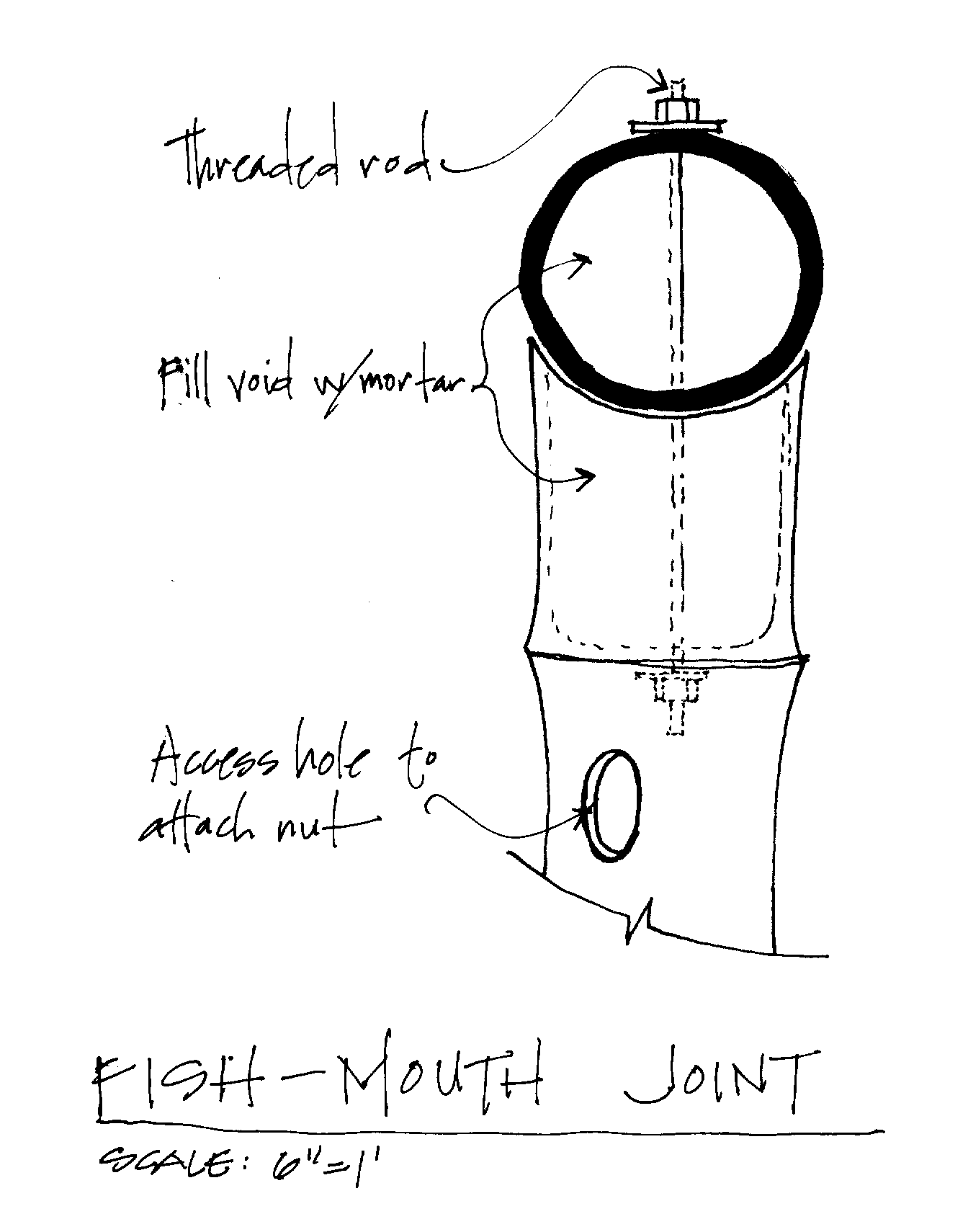Automobile
bridges with spans up to 150 feet have been built of bamboo by Jorg
Stamm in Colombia (see the Conbam site below for more on Jorg)
photo by Jorg Stamm
Bamboo has been
documented with over 1,500 different uses. In the area of building,
that includes fences, gates, trellises, and every part of a
structure. Bamboo tools, utensils, and buildings are an important
part of life for half the world's population. In temperate climates
around the world, bamboo supply can be maintained indefinitely while
maintaining erosion control, watershed integrity, soil health. What we lack is Summer rain.
As a building
material, bamboo is special both because it handles long spans
and has such intrinsic beauty.
The main reason we can – for the first time – look seriously
at this plant is the joinery system developed by Simon Velez and
others in Colombia.
It is the process
of establishing the production system appropriate to our culture and
time that is most important to think through now. Gaining access to
inexpensive land not usable for any other purpose, choosing
appropriate species, allowing the time for maturity, understanding
the aesthetics of working with cylindrical materials in a
predominantly rectilinear society, learning to find exceptional
working stock, and developing a design approach that takes full
advantage of both the strength and beauty of the timber bamboo –
these are our challenges.
Websites
American Bamboo Society
-- especially
the Species Source List (all bamboos in cultivation in
the U.S., sizes, temperature & shade tolerances) http://www.bamboo.org/abs/
1000 things
bamboo -- http://www.bambus.de/infos/1000/indexx.php
Building the ZERI
pavilion -- http://www.zeri.org/pavilion/slideshow/pav_small/slideshow.asp
German university site
-- http://www.conbam.de
Books published by INBAR
-- http://www.panasia.org.sg/ecom/mos/user/webdriver?MIval=MOS&START=1&WINSIZE=5&orgid=33&catid=4
Best source of bamboo
books in the U.S. -- http://www.bamboodirect.com
Bamboo Flooring --
http://www.4specs.com/s/09/09649.html
Code approval in the U.S. -- http://www.icbo.org/ICBO_ES/Acceptance_Criteria/pdf/ac162.pdf
International standards by
the author of the ICBO Acceptance Criteria, Dr. Jules Janssen -- http://www.bwk.tue.nl/bko/research/Bamboo/iso.htm
In Spanish, from the country
getting the most from bamboo -- http://www.asosismica.org/
Walk through several Velez
buildings -- http://home.earthlink.net/~montecito/irongrass.htm
Thoughts about bamboo flooring
from myself and Christi Graham -- http://www.kqed.org/topics/home/homeimprove/healthyhome-feature3.jsp

Find uses for
the much more common small diameters and easily-made splits; Bamboo
in tension is at its best (photo by Jaqueline Lytle)
Gazebos, trellises,
and arbors like the one I did above are some of the
first structure types that people think are associated with
bamboo. They're great, as long as one accepts that they won't
last long once exposed to the sun and rain. Bamboo performs
about like hardwoods and our douglas fir structural lumber, which
means it splits in the first couple of years of exposure, then it
bleaches gray in the sun. As long as the powder post beetles
don't find it, it will last for years, as long as you're ok with the
way it looks. Trellises can last for 20 or 30 years, less in
humid, wet climates. And the ability of this lightweight,
strong material to totally transform landscapes quickly is
unsurpassed. But, that's not even the best use of
the material. Our challenge is to find ways to use it
indoors where it's luster is preserved and it can continue to
look attractive indefinitely.
Sustainability
As an architect
with an interest in maintaining my supply of building materials, I
find that bamboo meets the basic criteria for continuous use. It is:
Renewable - The
Phyllostachys varieties, most suitable for growing and building in
the U.S. where we must deal with frost, will grow 12-18 inches a day
once a grove is established. Culms (the living poles) emerge as
large as they will ever be in that first six-week spurt, then spend
the next three years replacing sugars and water with silica and
cellulose. Structurally, they are only useful after that third year,
which is about when the culm is not needed by the plant.

5” dia. P.
vivax in the SF bay area.
The roots extend into the lawn, excess shoots are
transparently mowed
Plentiful - Our current
meager U.S. supply of timber-quality bamboo can increase manifold
within a decade with species selection appropriate to the
microclimate, water, and nutrient availability. For now, temperate
varieties such as Moso are being imported from Asia. These are well suited to
being grown here.
Local - Bamboo concentrates
a large amount of fiber in a small land area, creating that rare
situation in which a single person can be both producer and consumer
of a building material. A bamboo builder is not dependent upon the
whims of the marketplace and can create a long-term source of
material. Few other materials, besides earth, can make such claims.
Waste-reducing - As is
nature's general practice, nothing goes to waste. The leaves are
high in nitrogen, making good feed for livestock. Any fallen leaf compost goes
to fertilize the next generation. http://esi.athenstn.com/wwt/Bamboo_Bioremediation.html
But, even more enticing are the statistics for pulling carbon out of
the air, potentially reducing the amount of carbon dioxide that
contributes to the greenhouse effect. According to the people
at the Zero Emissions Research Institute (ZERI) who built the bamboo
pavilion at the top of this page, a bamboo forest can sequester 17
times as much carbon as a typical tree forest. In a country
where a third of the greenhouse gases are attributed to buildings,
imagine a building material that, when used locally, not only
doesn't contribute to global warming, it solves some small portion
of the problem.
STRUCTURAL
PROPERTIES
Bamboo is an
extremely strong fiber; with twice the compressive strength of
concrete and roughly the same strength-to-weight ratio of steel in
tension. In addition, testing (Janssen '97) has shown that the
hollow tube shape gives a strength factor of 1.9 over the equivalent
solid. The reason is that, in a beam, the only fibers doing work are
in the top (compression) and bottom (tension). The center is dead
weight.
The strongest
bamboo fibers have a greater shear strength than structural woods,
and they take much longer to come to ultimate failure. However, this
ability of bamboo to bend without breaking makes it unsuitable for
building floor structures because we have a very low tolerance for
deflection, and few here will accept a floor that feels "alive." On
the other hand, bamboo as a 3/4 inch thick finish floor is an
appropriate substitute for the standard oak because it installs the
same way, is harder and expands less.
Because of the
relative scarcity of timber bamboo in the U.S., one of the best uses
for this giant grass is as a truss, taking advantage of both its
strength and its beauty.

Garden
structure for Eric Lloyd Wright with new forms of triangulation and
stainless bands to resist splits (design by author)
Preferred Joinery

The
“fish-mouth” is the joint required when all the poles are in the
same plane – as in the “Not This” truss shown above. Though common in South
America, it is very labor intensive and most gringos prefer to avoid
it.
The joint of preference is allowed
by the three dimensional truss in the second diagram above,
developed by Simón Vélez in Colombia. This one is a simple bolted
connection, but because the bolt alone concentrates too much force
on the wall of the bamboo, the void between nodes is filled with a
solidifying mortar, increasing the surface area of the joint
significantly.
“Fish-Mouth” Joint


